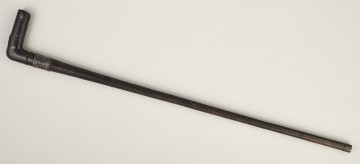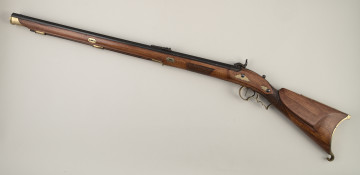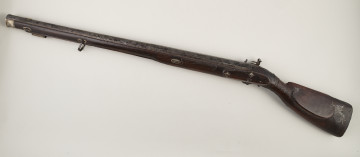
Shooting stick
20th century
Castle Museum in Łańcut
Part of the collection: Weapons, music instruments, varia
Rifle with Flint-Lock. The invention of gunpowder resulted in another “arms race” on battlefields. Work on new rifles was launched. To improve accuracy, more and more precise sights started to be applied, along with rifled barrels. An important element of the new firearms, allowing for shooting efficiently irrespective of the weather conditions and individual training, was the invention of a relatively reliable lock. The first locks, so-called match-locks, were very sensitive to weather conditions, while wheel-locks were expensive, complex and required professional handling. It was only the introduction of a flint-lock mechanism, in the second quarter of the 16th century that allowed for full use of firearms by the units of infantry and cavalry. The idea of operation of such locks consists in placement of a piece of flint between a set of jaws. After the hammer has been released, the flint strikes a piece of steel called the “frizzen” which creates a spark that falls into the pan and ignites the powder. Flame burns through a small touch hole into the gun barrel and ignites the main propellant charge, causing the weapon to fire off the projectile. The hunting rifle forming a part of the museum collection is provided with such lock (French type). The discussed rifle has a French type flint-lock which combines the best features of the northern and Mediterranean locks. The barrel is 645 mm long, it is rifled with 8 lands and grooves and has a 17 mm calibre. The total length of the rifle is 1,020 mm. It is dated at the second half of the 18th century. Given the fact that it is a hunting rifle, it was less exposed to damage or loss as a result of military actions, but could have only been afforded by affluent people and that is why more attention was paid to its decoration. The trigger guard features a chiselled Rococo ornament and a figure of a hunter with a rifle and a dog, while the brass butt plate ended with a flap is also decorated with a Rococo ornament and a figure of Diana with two dogs.
Author / creator
Dimensions
height: 103 cm, width: 14 cm
Object type
Weapons, instruments, varia
Technique
metallurgical
Material
wood, steel
Creation time / dating
Creation / finding place
Owner
Castle Museum in Łańcut
Identification number
Location / status

20th century
Castle Museum in Łańcut

18th century
Castle Museum in Łańcut

18th century
Castle Museum in Łańcut
DISCOVER this TOPIC
National Museum in Lublin
DISCOVER this PATH
Educational path